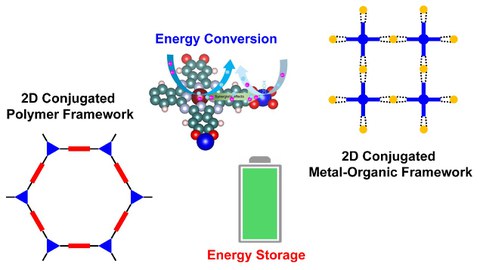Aug 11, 2020
Perspectives on Two-Dimensional Carbon-Rich Conjugated Frameworks for Electrochemical Energy Applications
The great success of graphene in electrochemical energy applications (EEAs) has stimulated the recent efforts dedicated to exploring two-dimensional (2D) carbon-rich materials with similar structure features. To this end, 2D carbon-rich conjugated frameworks (2D CCFs), which are built up with atomically ordered planar networks, have been brought into the spotlight. Similar to graphene, 2D CCFs are characterized by high in-plane π-conjugation and weak out-of-plane π-π stacking. The unique structures endow 2D CCFs with regular porosities, large specific surface areas, and superior chemical stability. Especially, 2D CCFs are prepared via bottom-up synthetic strategies, making it convenient to precisely tailor their geometries, catalytic/redox sites, and chemical/physical properties at the molecular level by using modern organic and polymer chemistries. The exploration of 2D CCFs for EEAs has only attracted scientific attention in the last few years. As an emerging research field, some critical challenges remain, particularly in establishing an unambiguous correlation between 2D CCF structures and their performances in different EEAs.
Recently, researchers from Technische Universität Dresden (Chair of Molecular Functional Materials) reported their perspectives on the development of 2D CCFs for EEAs. The structural features and synthetic principles of 2D CCFs (including 2D conjugated polymer frameworks and 2D conjugated metal-organic frameworks) are briefly introduced. Recent progress in 2D CCFs designed for diverse energy conversion (electrocatalysis) and storage (supercapacitors and batteries) applications is evaluated. Particular emphasis is put on analyzing the precise structural regulation of 2D CCFs that determines the electrochemical performances. Finally, an outlook is provided for the future development of this field, which concerns novel monomer design, chemical methodology/strategy establishment, and a roadmap toward practical applications.
This work was financially supported by the European Research Council (ERC) Consolidator grant under the European Union’s Horizon 2020 Research and Innovation Programme (T2DCP, grant no. 819698), ERC Starting Grant (FC2DMOF, grant no. 852909), GrapheneCore3 (grant no. 881603), the Deutsche Forschungsgemeinschaft (MX-OSMOPED project), M-ERA.- NET and Sachsisches Staatsministerium fur Wissenschaft und Kunst (HYSUCAP, grant no. 100478697), the German Research Foundation (DFG) within the Cluster of Excellence, CRC 1415 (grant no. 417590517), Polymer-based Batteries (SPP 2248, RACOF-MMIS), and Coordination Networks: Building Blocks for Functional Systems (SPP 1928, COORNET).
Reference:
Minghao Yu, Renhao Dong, Xinliang Feng*, Two-Dimensional Carbon-Rich Conjugated Frameworks for Electrochemical Energy Applications, J. Am. Chem. Soc. 2020, 142, 12903–12915.

